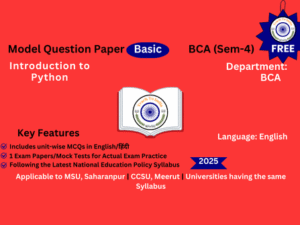Ecology, Ethology, Environmental Science and Wildlife - पारिस्थितिकी, नृविज्ञान, पर्यावरण विज्ञान और वन्यजीव विज्ञान – Adv
- Description
- Curriculum
- Reviews

Model Question Paper
Ecology, Ethology, Environmental Science and Wildlife – पारिस्थितिकी, नृविज्ञान, पर्यावरण विज्ञान और वन्यजीव विज्ञान
Key Features | मुख्य विशेषताएँ
-
Bilingual Model Paper | द्विभाषी मॉडल पेपर
This model paper is Designed in English and Hindi, making it easier for students from both mediums to understand and practice effectively.
यह मॉडल पेपर अंग्रेज़ी और हिंदी दोनों भाषाओं में डिज़ाइन किया गया, जिससे दोनों माध्यमों के छात्रों को अध्ययन और अभ्यास करने में आसानी हो। -
Unit-wise Short Notes | इकाईवार संक्षिप्त नोट्स
Each unit includes a summary in both languages, making revision faster and more effective.
प्रत्येक इकाई में दोनों भाषाओं में सारांश उपलब्ध है, जिससे पुनरावृत्ति तेज़ और प्रभावी हो सके। -
Extensive MCQ Practice | विस्तृत MCQ प्रैक्टिस
1500+ MCQ Practice Questions: This comprehensive question bank includes 1500+ multiple-choice questions (MCQs). Each unit contains approximately 150 MCQs covering a wide range of cognitive levels such as remembering, understanding, application, and analysis.
1500+ MCQ अभ्यास प्रश्न: इस प्रश्न बैंक में 1500 से अधिक बहुविकल्पीय प्रश्न (MCQ) शामिल हैं। प्रत्येक यूनिट में लगभग 150 MCQ हैं, जो याददाश्त, समझ, अनुप्रयोग और विश्लेषण जैसे विभिन्न संज्ञानात्मक स्तरों को कवर करते हैं। -
Exam Practice Paper with Mock Tests | मॉक टेस्ट के साथ परीक्षा अभ्यास पत्र
Includes three full-length mock tests for real exam practice.
तीन पूर्ण मॉक टेस्ट दिए गए हैं, जिससे छात्र वास्तविक परीक्षा अभ्यास कर सकें। -
Latest Syllabus as per NEP | NEP के अनुसार नवीनतम पाठ्यक्रम
The syllabus aligns with the latest National Education Policy (NEP) and follows the exam patterns of MSU, CCSU, and other universities following the NEP.
पाठ्यक्रम नवीनतम राष्ट्रीय शिक्षा नीति (NEP) के अनुसार है और यह MSU, CCSU तथा अन्य NEP का पालन करने वाले विश्वविद्यालयों की परीक्षा प्रणाली का अनुसरण करता है। -
Designed by Experts | विशेषज्ञों द्वारा तैयार किया गया
This question bank has been meticulously prepared by subject matter experts to ensure accuracy and relevance.
यह प्रश्न बैंक विषय विशेषज्ञों द्वारा सावधानीपूर्वक तैयार किया गया है, जिससे इसकी सटीकता और प्रासंगिकता बनी रहे।
Why Choose This Model Paper? | यह मॉडल पेपर क्यों चुनें?
-
Dual-Language Advantage: Ideal for both English and Hindi medium students.
द्विभाषी लाभ: अंग्रेज़ी और हिंदी दोनों माध्यमों के छात्रों के लिए उपयुक्त। -
Complete Exam Preparation: Unit-wise summaries, MCQ practice, and mock tests provide a complete study solution.
पूर्ण परीक्षा तैयारी: इकाईवार सारांश, MCQ अभ्यास, और मॉक टेस्ट संपूर्ण अध्ययन समाधान प्रदान करते हैं। -
Latest NEP-Based Pattern: Ensures compliance with the latest university exam structure.
नवीनतम NEP-आधारित पैटर्न: यह नवीनतम विश्वविद्यालय परीक्षा संरचना के अनुरूप है।
|
Program Class: Degree / B.Sc |
Year: Third |
Semester: Six |
||
|
Subject: ZOOLOGY |
||||
|
Course Title: Ecology, Ethology, Environmental Science and Wildlife |
||||
|
Course Learning Outcomes: On completion of this course, learners will be able to: · Complexities and interconnectedness of various environmental levels and their functioning. · Global environmental issues, their causes, consequences and amelioration. · To understand and identify behaviours in a variety of taxa. · The proximate and ultimate causes of various behaviours. · About the molecules, cells, and systems of biological timing systems. · Conceptualizing how species profitably inhabit in the temporal environment and space out their activities at different times of the day and seasons. · To interpret the cause and effect of lifestyle disorders contributing to public understanding of biological timing. · To understand the importance of wildlife conservation. |
||||
|
Credits: 4 |
Core Compulsory |
|||
|
Max. Marks: –25+75 |
Min. Passing Marks: 33 |
|||
|
Unit |
Topics |
|||
|
I |
Introduction to Ecology · History of ecology, Autecology and synecology, · Levels of organization, Laws of limiting factors, · Study of physical factors |
|||
|
II |
Organization of Ecosystem · Levels of organization, Laws of limiting factors, Study of physical factors, · Population: Density, natality, mortality, life tables, fecundity tables, survivorship curves, age ratio, sex ratio, dispersal and dispersion ,Exponential and logistic growth, · Types of ecosystems with one example in detail, Food chain: Detritus and grazing food chains, , Food web, Energy flow through the ecosystem, · Ecological pyramids and Ecological efficiencies, Nutrient and biogeochemical cycle with one example of Carbon cycle |
|||
|
III |
Community Ecology Community characteristics: species richness, dominance, diversity, abundance, Ecological succession with one example |
|||
|
IV |
Environmental Hazards · Sources of Environmental hazards · Climate changes. Basics of environmental impact assesement · Greenhouse gases and global warming · Acid rain, Ozone layer destruction |
|||
|
V |
Effects of Climate Change · Effect of climate change on public health · Sources of waste, types and characteristics, Sewage disposal and its management, Solid waste disposal, Biomedical waste handling and disposal, · Nuclear waste handling and disposal, Waste from thermal power plants, · Case histories on Bhopal gas tragedy, Chernobyl disaster and their aftermath. |
|||
|
VI |
Behavioural Ecology and Chronobiology · Origin and history of Ethology, · Instinct vs. Learnt Behaviour · Associative learning, classical and operant conditioning, Habituation, Imprinting, · Biological clocks, Circadian rhythms; Tidal rhythms and Lunar rhythms, circannual rhythms · Chronomedicine |
|||
|
VII |
Introduction to Wild Life · Values of wild life – positive and negative; Conservation ethics; Importance of conservation; Causes of depletion; World conservation strategies. |
|||
|
VIII |
Protected areas · National parks & sanctuaries, Community reserve; Important features of protected areas in India; Tiger conservation – Tiger reserves in India; Management challenges in Tiger reserve |
|||
-
1Unit 1: English Summary - Ecology, Ethology, Environmental Science and Wildlife
-
2Unit 1: Hindi Summary - Ecology, Ethology, Environmental Science and Wildlife
-
3Unit 1: MCQs - Ecology, Ethology, Environmental Science and Wildlife- Adv
-
4Unit 2: English Summary - Ecology, Ethology, Environmental Science and Wildlife
-
5Unit 2: Hindi Summary - Ecology, Ethology, Environmental Science and Wildlife
-
6Unit 2: MCQs - Ecology, Ethology, Environmental Science and Wildlife- Adv
-
7Unit 3: English Summary - Ecology, Ethology, Environmental Science and Wildlife
-
8Unit 3: Hindi Summary - Ecology, Ethology, Environmental Science and Wildlife
-
9Unit 3: MCQs - Ecology, Ethology, Environmental Science and Wildlife- Adv
-
10Unit 4: English Summary - Ecology, Ethology, Environmental Science and Wildlife
-
11Unit 4: Hindi Summary - Ecology, Ethology, Environmental Science and Wildlife
-
12Unit 4: MCQs - Ecology, Ethology, Environmental Science and Wildlife- Adv
-
13Unit 5: English Summary - Ecology, Ethology, Environmental Science and Wildlife
-
14Unit 5: Hindi Summary - Ecology, Ethology, Environmental Science and Wildlife
-
15Unit 5: MCQs - Ecology, Ethology, Environmental Science and Wildlife- Adv
-
16Unit 6: English Summary - Ecology, Ethology, Environmental Science and Wildlife
-
17Unit 6: Hindi Summary - Ecology, Ethology, Environmental Science and Wildlife
-
18Unit 6: MCQs - Ecology, Ethology, Environmental Science and Wildlife- Adv
-
19Unit 7: English Summary - Ecology, Ethology, Environmental Science and Wildlife
-
20Unit 7: Hindi Summary - Ecology, Ethology, Environmental Science and Wildlife
-
21Unit 7: MCQs - Ecology, Ethology, Environmental Science and Wildlife- Adv
-
22Unit 8: English Summary - Ecology, Ethology, Environmental Science and Wildlife
-
23Unit 8: Hindi Summary - Ecology, Ethology, Environmental Science and Wildlife
-
24Unit 8: MCQs - Ecology, Ethology, Environmental Science and Wildlife- Adv







